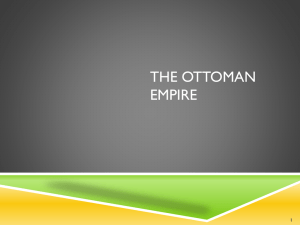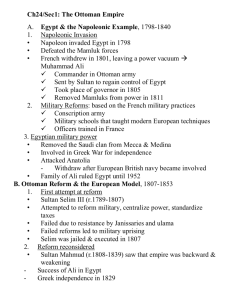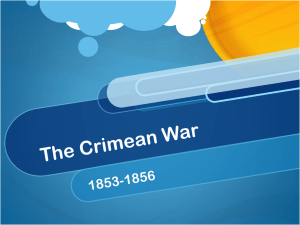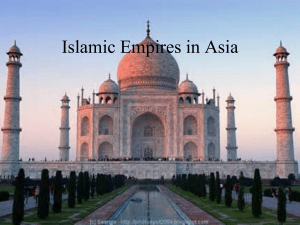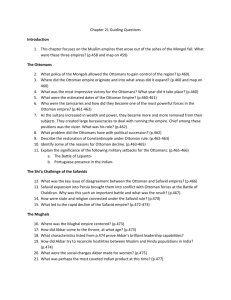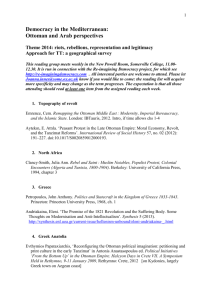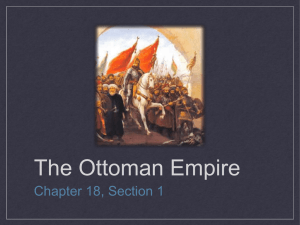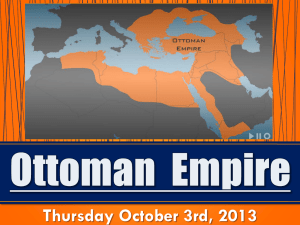artikel in Word
advertisement
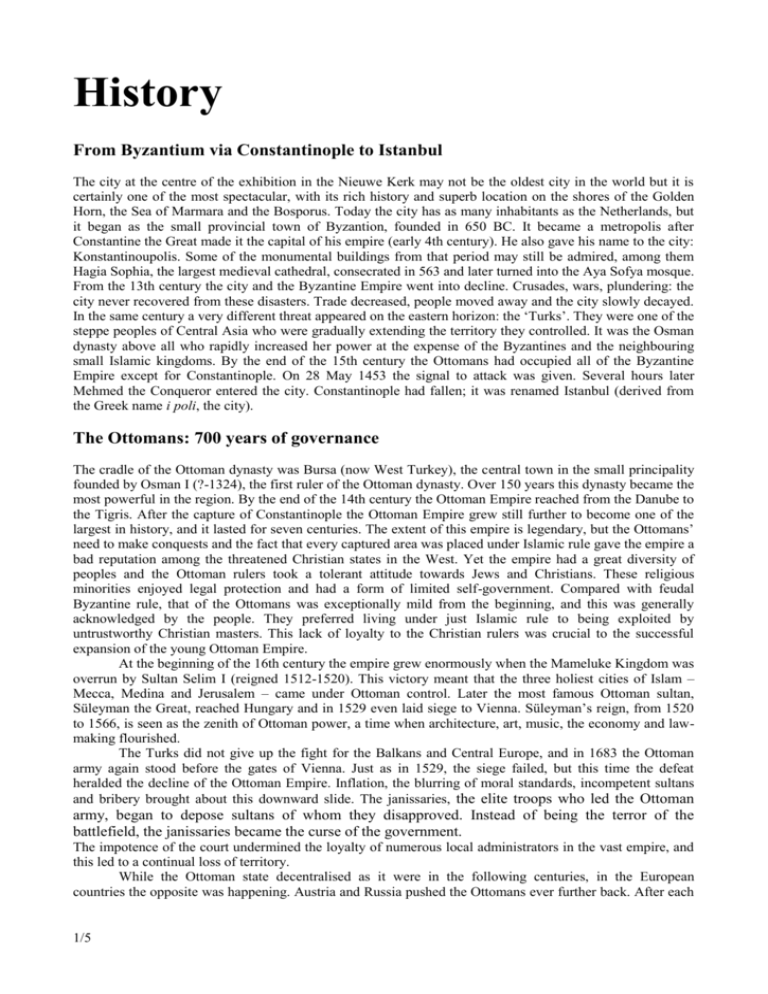
History From Byzantium via Constantinople to Istanbul The city at the centre of the exhibition in the Nieuwe Kerk may not be the oldest city in the world but it is certainly one of the most spectacular, with its rich history and superb location on the shores of the Golden Horn, the Sea of Marmara and the Bosporus. Today the city has as many inhabitants as the Netherlands, but it began as the small provincial town of Byzantion, founded in 650 BC. It became a metropolis after Constantine the Great made it the capital of his empire (early 4th century). He also gave his name to the city: Konstantinoupolis. Some of the monumental buildings from that period may still be admired, among them Hagia Sophia, the largest medieval cathedral, consecrated in 563 and later turned into the Aya Sofya mosque. From the 13th century the city and the Byzantine Empire went into decline. Crusades, wars, plundering: the city never recovered from these disasters. Trade decreased, people moved away and the city slowly decayed. In the same century a very different threat appeared on the eastern horizon: the ‘Turks’. They were one of the steppe peoples of Central Asia who were gradually extending the territory they controlled. It was the Osman dynasty above all who rapidly increased her power at the expense of the Byzantines and the neighbouring small Islamic kingdoms. By the end of the 15th century the Ottomans had occupied all of the Byzantine Empire except for Constantinople. On 28 May 1453 the signal to attack was given. Several hours later Mehmed the Conqueror entered the city. Constantinople had fallen; it was renamed Istanbul (derived from the Greek name i poli, the city). The Ottomans: 700 years of governance The cradle of the Ottoman dynasty was Bursa (now West Turkey), the central town in the small principality founded by Osman I (?-1324), the first ruler of the Ottoman dynasty. Over 150 years this dynasty became the most powerful in the region. By the end of the 14th century the Ottoman Empire reached from the Danube to the Tigris. After the capture of Constantinople the Ottoman Empire grew still further to become one of the largest in history, and it lasted for seven centuries. The extent of this empire is legendary, but the Ottomans’ need to make conquests and the fact that every captured area was placed under Islamic rule gave the empire a bad reputation among the threatened Christian states in the West. Yet the empire had a great diversity of peoples and the Ottoman rulers took a tolerant attitude towards Jews and Christians. These religious minorities enjoyed legal protection and had a form of limited self-government. Compared with feudal Byzantine rule, that of the Ottomans was exceptionally mild from the beginning, and this was generally acknowledged by the people. They preferred living under just Islamic rule to being exploited by untrustworthy Christian masters. This lack of loyalty to the Christian rulers was crucial to the successful expansion of the young Ottoman Empire. At the beginning of the 16th century the empire grew enormously when the Mameluke Kingdom was overrun by Sultan Selim I (reigned 1512-1520). This victory meant that the three holiest cities of Islam – Mecca, Medina and Jerusalem – came under Ottoman control. Later the most famous Ottoman sultan, Süleyman the Great, reached Hungary and in 1529 even laid siege to Vienna. Süleyman’s reign, from 1520 to 1566, is seen as the zenith of Ottoman power, a time when architecture, art, music, the economy and lawmaking flourished. The Turks did not give up the fight for the Balkans and Central Europe, and in 1683 the Ottoman army again stood before the gates of Vienna. Just as in 1529, the siege failed, but this time the defeat heralded the decline of the Ottoman Empire. Inflation, the blurring of moral standards, incompetent sultans and bribery brought about this downward slide. The janissaries, the elite troops who led the Ottoman army, began to depose sultans of whom they disapproved. Instead of being the terror of the battlefield, the janissaries became the curse of the government. The impotence of the court undermined the loyalty of numerous local administrators in the vast empire, and this led to a continual loss of territory. While the Ottoman state decentralised as it were in the following centuries, in the European countries the opposite was happening. Austria and Russia pushed the Ottomans ever further back. After each 1/5 crisis the Ottomans were forced to promise to introduce reforms. By fits and starts the state began to modernise, generally on the basis of Western ideas. The Ottoman sultans followed suit: the court was modernised too. In 1853 the dynasty left Topkapi Palace after 400 years and moved into the brand-new, modern Dolmabahce Palace on the Bosporus. Meanwhile the ambitious modernisation programme, with new investment in railways, ports and roads, was costing the government a fortune. It even led to the state going bankrupt in 1875. Apart from the dire financial position, the continued existence of the empire was undermined by various insurgent peoples: Greeks, Bulgars, Serbians and many others left the state. In reaction the government tried to promote its own brand of nationalism among the people, so-called Ottomanism. Nationalism based on one’s own community had more appeal, however, both among the Turks and other ethnic groups like Arabs, Albanians and Kurds After the coup against Sultan Abdul-Hamid in 1908, the state appeared to be reviving, but the idealists of the early days soon turned out to be dictators. When the junta decided in 1914 to take part in the First World War on the side of Austria and Germany, its fate was sealed. In 1918 all the Arab territories were already lost, and this was followed by the further partition of the whole of Anatolia. The revolt against this course of events led by General Mustafa Kemal Pasha, better known as Atatürk, resulted in the founding of the state of Turkey in 1923. A year earlier the last Ottoman sultan, Mehmed VI, had been deposed and exiled abroad. This marked the end of one of the longest-ruling dynasties, the Ottomans. Istanbul: centre of power and bridge between East and West After being captured by the Ottomans in 1453, Istanbul became the centre of the powerful Ottoman Empire. The city grew rapidly: the walls were repaired and new houses, mosques, schools and hospitals were built. On the spit of land separating the Sea of Marmara from the Golden Horn work began on constructing the new (‘Topkapi’) palace on the remains of the former Byzantine acropolis. This palace remained the residence of the Ottoman sultans and their court until well into the 19th century. The sultans saw to it that the important public facilities indispensable for a city were provided: the (still extant) Great Bazaar, bathhouses and shops. The old city was inhabited by Muslims, Greeks, Jews, Armenians and gypsies. On the opposite shore lived the Europeans, in the former Genoese settlement of Galata. Around 1600, Western observers estimated that the city already had more than a million inhabitants. Many of them were janissaries and court personnel. Their number grew from 13,000 in 1475 to 100,000 (!) in 1669. Istanbul was laid out as an Islamic city. A characteristic feature is the division into a large number of districts (mahalles) built round a local mosque. The three large central mosques (the Aya Sofya, the Süleymaniye and the Blue Mosque) were more than community centres. They had important ceremonial functions and dominated the skyline of old Istanbul (as they still do today). Other important places in the city were the bathhouses, the mausoleums, the learning centers and the dervish monasteries. In 1871 Istanbul had 284 Islamic, 24 Greek, 14 Armenian and 19 Jewish districts. The exhibition Inside the Nieuwe Kerk a city with twelve buildings is being constructed by Kossman.DeJong Exhibition Architects which will cover a range of subjects from the rich history of Istanbul. The bazaar The principal market in the old city is the Great Bazaar. In 1456 it was decided to build a bedestan, the central brick complex of the market. In the course of the 15th and 16th centuries a thousand shops and workplaces grew up around it. The streets were roofed over, which resulted in the present complex with its thirty entrance gates. One part of the Great Bazaar was the Book Bazaar, with sixty bookshops and libraries. In the 17th century the second important bazaar, the Egyptian market, was established close by. It dealt 2/5 mainly in spices and herbs, and still does today. In addition to these large bazaars, Istanbul had numerous small markets and bedestans. This is where the slave trade took place. Until far into the 19th century Istanbul was an important centre of this trade. The coffee house ‘I know of no greater pleasure than to sip a cup of mocha in a Turkish coffee house.’ Marius Bauer, painter, 1896 Coffee reached Istanbul from Yemen in the middle of the 16th century. It proved very popular and the coffee houses soon became the main centres of social life in the city. There was a wide range to choose from; sumptuous and comfortable for the rich, bare and impoverished for the poor. And there were coffee houses for Muslims and non-Muslims, for Greeks, Persians and certain professional groups such as the janissaries. As with tobacco, opinion was divided. Conservative clerics denounced this modernism; others were afraid of gatherings and conspiracies. To this day the popularity of the coffee house has remained undiminished. The bathhouse Another place for relaxation and enjoyment was the hamam, the public bathhouse. It was a legacy from the Romans and Byzantines which the Muslims gladly adopted. Soon after the fall of Constantinople the Ottomans built the first bathhouses, sometimes on the ruins of earlier Byzantine baths. The sultans also had bathhouses built, often by their own architects. In the 16th century Istanbul had 150 bathhouses.. Like the coffee house, the bathhouse played an important role in social life. Wooden villas Outside the walls of the ever expanding and crowded city beautiful wooden villas were built beside the waters of the Golden Horn and the Bosporus. Complete with boathouse and jetty, they were known as yalis. Although they were often inconspicuous when seen from outside, the interior would be lavish, with expensive carpets, skilfully carved woodwork and comfortable divans. The residents of these villas were the administrative elite. They were used as summer houses and for festive gatherings, weddings and hunting parties. Under the influence of Western fashions, the outward appearance of the villas changed in the 19th century and here and there elegant buildings with carvings and frills were seen. Many of these yalis may still be admired along the Bosporus. Cemetery ‘Stambul is buried under graves. People like them. They reach as far as the courtyards of houses...’. Le Corbusier, 1911 The cemeteries laid out in valleys or against hillsides were a favourite destination for day trips. The sense of melancholy, decline and desolation was strengthened by the fact that the gravestones were chaotically mixed up, with no apparent arrangement. The men’s stones are traditionally crowned by a carved turban; those of women are marked by flowers or a scarf. The mosque Although the Turks were not originally Muslims, the forefathers of the first sultan, Osman, had embraced Sunni Islam. As the empire expanded, in the 16th century it grew to be one of the mightiest and most important Islamic states in history. This power was symbolised by the three great mosques, the Aya Sofya, the Blue Mosque and the Süleymaniye, which still dominate the city’s skyline. These three mosques were part of a conglomeration of buildings, courtyards, gardens and promenades. The outbuildings housed religious schools, hospitals, soup kitchens, washhouses and sometimes a separate bathhouse. The tekke 3/5 Within Ottoman Islam there was not only an emphasis on formal rules and rites, but also a great interest in the mysterious and mystical. Accordingly, the urban landscape featured hundreds of tekkes, buildings where practising mystics (Sufis or dervishes) came together for study and contemplation, before losing themselves and becoming totally absorbed in the divine. The most widely used method for this was to practise zikir (endlessly repeating the name of Allah), the famous whirling round and self-chastisement. Music, incense, alcohol and other addictives were also used to induce a euphoric state. Up to the beginning of the 20th century nearly all Ottoman men were members of a Sufi society, the sultans included. The library In the Ottoman Empire Turkish was the dominant language, both as the spoken language and in the written form for the bureaucracy and for literature and scholarship. Arabic remained the language for religious and legal texts, while Persian had an important role in mystical poetry. Paper was expensive, however, and few people could afford these costly books. As a result of falling paper prices, public libraries were founded in Istanbul in the 17th and 18th centuries. Books dating from before 1800 contained handwritten texts and miniatures and were usually produced to order for the Topkapi library or the private library of an extremely wealthy minister or merchant. Life in Topkapi Palace The Ottoman sultan held political power and was also the commander-in-chief and religious leader. He was certainly an autocratic head of state, but not the kind of oriental despot many Western leaders accused him of being. His power was limited by the sharia, the Holy Law of Islam. The sultans were seen in Islam as the successors of the Prophet Mohammed. After the conquest of Istanbul in 1453, Sultan Mehmed II built a palace on the spit of land where the Bosporus and the Golden Horn meet. Some 60 hectares were cleared for the project. The only building left standing was the former Byzantine church of St. Irene, which in future would serve as the palace’s arsenal. The palace complex consists not of one monumental building, but of a series of large and small buildings, gardens, courtyards and gates. The Imperial Gate gives access to the outer court or first courtyard. Here are the sick bay, storehouses, stables and dormitories. Next comes the second courtyard, reached through the Middle Gate and open only to a select group. This broad court ends at the kitchens of the seraglio. Opposite is the meeting chamber of the divan (council of state). Here impressive ceremonial occasions took place, such as the paying of the elite corps of janissaries and audiences with foreign ambassadors. The ruler took his place on his throne in the throne room immediately behind the Gate of Happiness, which led to his private apartments. The sultan thus received the foreigners on the line dividing his public from his private life. The Dutch at the court The earliest relations between the Netherlands and Turkey date from the time of the Eighty Years War. The trade with the ‘Levant’, the eastern Mediterranean, moved from Antwerp to the ports in the Northern Netherlands. From the 17th century the Turks could be found on the Amsterdam commodity exchange. Trade contacts became more extensive and in 1611 the first Dutch ambassador, Cornelis Haga, left for Istanbul. He settled in the European quarter, in a palace on a site where the present embassy stands. Since then the Netherlands has maintained good relations with Turkey, and there has been a long series of ambassadors and consuls in Istanbul, Ankara and many other centres. In 1924 a new friendship treaty was agreed between Ankara, the new capital, and The Hague. At the embassies and consulates a prominent role was played by the dragomans. They were experts on Ottoman law and customs and key figures in the diplomatic traffic with the court. In the heart of the palace Very exceptionally the Grand Vizier, the head of the government, and the Grand Mufti, the head of the religious hierarchy, were allowed to enter the second courtyard through the Gate of Happiness. The court beyond that forms the closed part of the palace with the private quarters of the sultan and his family and their 4/5 400 courtiers. This part of the complex also consisted of numerous rooms, pavilions, gardens and courtyards. Over the centuries different sultans added on pavilions and other buildings. What was destroyed by fire was rebuilt many times. The most important part of the private palace was the women’s quarters, the harem. The harem This part of the palace was not the idyllic spot so often described and depicted in Western sources. Westerners were given access only very rarely. Consequently, most of the Western reports are fiction. This part of the palace was a rigidly organised and structured entity and the exclusive domain of the women and their guards, the black eunuchs. At the head of the harem was the valide sultan, the mother of the reigning sultan. A woman began her career in the harem as a handmaid before rising to pupil, companion and mistress. The sultan chose his sleeping partners from the last group. The sultan’s favourites were known as has odalik (compare L’Odalisque by Ingres). They had their own household within the harem. The women were foreigners because Islamic law forbade the enslaving of free-born Muslims. They sometimes included women from the Venetian or Genoese nobility or other distinguished backgrounds who had been taken prisoner. Most of the women left the harem sooner or later. On the death of the sultan all the childless concubines were released. The surviving wives and favourites with children were taken to the so-called Old Palace, where they were often married off to high-ranking husbands. For more information: The Nieuwe Kerk Press Office Noepy Testa & Wieke van Veggel T: 00.31. (0)20 626 81 68 F: 00.31. (0)20 622 66 49 E: pressoffice@nieuwekerk.nl I: www.nieuwekerk.nl 5/5


